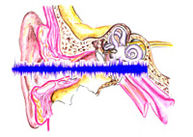Noise society: How does it affect our noise?
Write to the following email, for more information related to tinnitus:
[email protected]
WE LOOK FOR THE MOST ADEQUATE TREATMENT FOR RINGING AND BUZZING IN THE EARS

I Jornada de actualización en el abordaje y tratamiento de los acúfenos – Bienvenida
Cómo abordar los Acúfenos. Mi protocolo de diagnóstico
Lenire: La Neuroestimulación bimodal: una nueva arma en el tratamiento de los Acúfenos
Abordaje y tratamiento psicológico de los Acúfenos
TRT (“Tinnitus Retraining Therapy”): indicaciones y tratamiento
Fisioterapia en el Tratamiento de los Acúfenos. Cuándo y cómo
Mesa Redonda para discusión y para contestar las preguntas de los asistentes
TINNITUS
What is tinnitus?
Tinnitus is the hearing of noises, sounds or ringing in the ear or in the head that are not caused by an outside source. It can manifest itself in many ways, such as noise, buzzing, ringing, whooshing or humming in the ear. The noise in the ear can be intermittent or continuous and can be in one or both ears, or generally around the head.
Almost everyone has experienced tinnitus at some point, even if only temporarily.
An example is the typical sensation of noise in the ear after a concert or event in which the ear has been exposed to high volume sound.
Tinnitus becomes problematic if it persists or increases over time. The patient’s quality of life will be affected to some degree, depending on the intensity and frequency of the noise sensation.
Tinnitus is not always linked to hearing loss. Approximately 30% of people suffering from significant deafness do not have tinnitus, yet around 18% of the population suffers from some form of tinnitus.
What do tinnitus patients feel?
Most patients with tinnitus end up getting used to the noise in the ears, although 10% suffer from considerable implications, such as the loss of concentration, difficulty falling asleep or severe emotional distress that can lead to depression.
In cases where the patient develops an obsession over the tinnitus, the situation becomes more difficult to control. The obsession overstimulates the brain and makes the situation worse, resulting in the patient experiencing feelings of hopelessness.
In 40% of cases of tinnitus, the patient also suffers from hearing impairment or heightened sensitivity to external sound.
What causes tinnitus?
- injuries to the auditory canal that cause hearing loss (presbycusis or aging of the ear; diseases common to the outer, middle or inner ear; acoustic trauma; ear infections; Ménière’s disease, etc.);
- poor posture that mainly affects the temporomandibular and cervical muscle (bruxism or teeth grinding while sleeping, as well as other poor craniofacial habits, cervical arthrosis, contractures, abnormal back alignment, etc.);
- work or family-related stress. We should point out that patients with tinnitus are found to experience greater cerebral activity in the auditory cortex and limbic system, which is the part of the brain that is most involved with the emotions.
How is tinnitus diagnosed?
- otoscopy or examination of the outer ear and the eardrum with a microscope
- examination of painful craniofacial and cervical vertebrae areas
- audiometry, or test to measure the sensitivity of the ear to different sound frequencies
- acuphenometry to accurately identify the type of tinnitus
- pain threshold
- further tests (analysis, CAT, MRI and MRA scans, Cervical Vertebrae X-ray, Eco-doppler, etc.)
- questionnaire on the severity of the tinnitus
How is tinnitus treated?
- medication. Generally, cerebral vasodilators are used to reduce the intensity of tinnitus, and even to eliminate it altogether. If the tinnitus persists, other medicines are used to control the extent of brain stimulation, such as melatonin, sulpiride, hydroxyzine and lyrica, etc. If necessary, anxiolytics such as alprazolam or amitriptyline can also be prescribed;
- TRT (Tinnitus Retraining Therapy). TRT is currently the most widely used therapy. It aims to get patients used to the tinnitus, so that they are unaware of perceiving the sound;
TRT has two stages: the first is therapeutic advice (detailed explanation of the problem) and the second is sound therapy (to reduce the perception of the sound). Sound therapy will sometimes involve the use of sound generators, which for patients with considerable hearing loss will be fitted onto the conventional hearing aid;
- rehabilitation. In cases involving muscular contractions or poor posture, the patient will be referred for rehabilitation;
- tinnitus masker. This involves fitting a device, in the same way as a hearing aid, that emits low-level sounds directly into the masked ear, consequently masking and concealing the noise produced by tinnitus. The device reverses the soundwave stemming from tinnitus making the tinnitus disappear for varied period of time (minutes, hours or even days);
- hearing aid. If the patient has reduced hearing ability, in many cases the tinnitus can disappear or lessen with the fitting of a hearing aid (the patient hears ambient noise instead of the buzzing in the ears caused by the tinnitus).
Examples of white noise
Click on the following links to hear some examples of white noise: